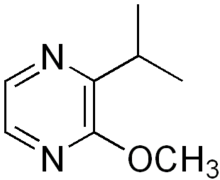Isopropyl methoxy pyrazine
Isopropyl methoxy pyrazine (IPMP) is a methoxypyrazine, a class of chemical compounds that produce odors. The odor is rather undesirable and is produced by the Asian lady beetle or by the actinomycete Streptomyces sp.[1] It can be detected by human taste at concentrations of as low as 2 nanograms per litre.[2]
 | |
| Names | |
|---|---|
| IUPAC name
2-methoxy-3-propan-2-ylpyrazine | |
| Other names
IPMP 2-Isopropyl-3-methoxypyrazine 3-Isopropyl-2-methoxypyrazine | |
| Identifiers | |
3D model (JSmol) |
|
| ChemSpider | |
| ECHA InfoCard | 100.042.946 |
PubChem CID |
|
| UNII | |
CompTox Dashboard (EPA) |
|
| |
| |
| Properties | |
| C8H12N2O | |
| Molar mass | 152.19 g/mol |
Except where otherwise noted, data are given for materials in their standard state (at 25 °C [77 °F], 100 kPa). | |
| Infobox references | |
Presence in wine grapes
The odor of IPMP tends to be undesirable in the case of certain wines.[3]
Cabernet Sauvignon has high levels of methoxypyrazines.[4][5] Two methoxypyrazine compounds, 3-isobutyl-2-methoxypyrazine (IBMP) and 3-isopropyl-2-methoxypyrazine, are considered to be important determinants of green flavours in Sauvignon blanc wines.[6]
Presence in coffee
IPMP is also an important flavour compound in coffee and is responsible for causing an off-taste called "potato taste" in East African coffee.[7] The insects Antestiopsis are also implicated in causing the taste.[8]
See also
References
- Three highly odorous metabolites from an actinomycete: 2-Isopropyl-3-methoxy-pyrazine, methylisoborneol, and geosmin. Nancy N. Gerber, Journal of Chemical Ecology, Volume 3, Number 4, pp. 475-482, doi:10.1007/BF00988190
- Cristina Sala; Olga Busto; Josep Guasch; Fernando Zamora. Factors affecting the presence of 3-alkyl-2- methoxypyrazines in grapes and wines. A review (PDF) (Report). Retrieved 2012-04-01.
- Trace flavour components of grapes
- winepros.com.au Oxford Companion to Wine methoxypyrazines Archived 2012-02-29 at the Wayback Machine
- Oz Clarke Encyclopedia of Grapes pg 223 Harcourt Books 2001 ISBN 0-15-100714-4
- Marais, J., Hunter, J.J., & Haasbroek, P.D. (1999). Effect of microclimate, season and region on Sauvignon blanc grape composition and wine quality. South African Journal of Enology and Viticulture, 20, 19-30.
- Czerny, M.; Grosch, W. (2000). "Potent Odorants of Raw Arabica Coffee. Their Changes during Roasting". Journal of Agricultural and Food Chemistry. 48 (3): 868–872. doi:10.1021/jf990609n. PMID 10725165.
- B. Bouyjou; B. Decazy; G. Fourny. "L'élimination du " goût de pomme de terre " dans le café Arabica du Burundi" [Removing the "potato taste" from Burundian Arabica]. Plantations, Recherche, Développement (in French). 6 (2): 107–115.